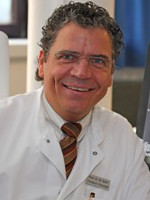The tasks of the pancreas include the production of insulin and digestive juices. No other body can perform these functions. A constant decrease in function occurs during the course of aging, whereby this process can be accelerated by many events (e.g. inflammation of the pancreas). A partial surgical removal of the pancreas inevitably leads to a decrease in function, a complete removal to a functional failure of the gland.
The digestive enzymes amylase and lipase of the pancreas are necessary to digest starch and fat from food. Insufficient function of the enzymes leads to impaired absorption of carbohydrates and / or fats, so that a deficiency of these necessary substances can occur. In addition, the lack of absorption of dietary fats in the intestine can lead to abdominal pain and diarrhea or fatty stools.
The function of the pancreas is best measured by detecting the enzymes in stool. The determination of the elastase in the stool is the best parameter, since it is also meaningful in the case of therapy with animal enzymes.
If the pancreas is not functioning properly, the missing enzymes should be added to the diet. For this there are several manufacturers of corresponding products that have to be added in capsule form or as juice with the meal.
One of the most important functions of the pancreas is the production of insulin. No other organ can compensate for a decrease in insulin production. If insulin production is not enough to keep blood sugar levels within normal limits, this is called diabetes mellitus. Depending on the severity of the insulin deficiency, blood sugar regulation can be optimized by restricting sugar intake with eating (diet), by increasing the remaining insulin effect (medication) or by administering insulin.
The extent to which diabetes occurs after an operation depends both on the function of the pancreas before the operation and on the extent of the operation. Unfortunately, there is no good parameter that can be used to estimate the risk of postoperative diabetes development before surgery. This fact should have an impact on the indication for an operation, especially in benign pancreatic diseases. So it should always be considered whether the benefits of surgery outweigh the risk of developing diabetes.
Benign Diseases of Pancreas
Acute and chronic inflammation are common diseases of the pancreas. But benign tumors also occur in the pancreas. However, many of these tumors have the characteristic that they can degenerate over time, i.e., become malignant. It is therefore important for these tumors to estimate the risk of degeneration. Some investigations can be useful for this, but they must then be interpreted with a lot of experience. Experts in radiology, internal medicine and surgery are available at the Mainz University Medical Center for this interpretation.
Acute pancreatitis
Acute inflammation of the pancreas (pancreatitis) is a reason for surgery only in exceptional cases. Nowadays, most complications of pancreatitis can be remedied without surgery. Only in those cases where areas of dead tissue (so-called necrosis) form around the pancreas, which are then infected by bacteria from the intestinal tract, surgery must be carried out, unless other measures such as the administration of antibiotics or interventional drainage pads are not work sufficiently.
Chronic pancreatitis
Chronic pancreatic disease can be inherited from recurrent acute inflammation or, more often, from chronic alcohol abuse. However, there are a variety of other causes of chronic pancreatitis, which often cannot be clearly assigned in individual cases.
In addition to a permanent loss of function of the pancreas, severe pain or an obstacle to drainage of the bile duct are common symptoms of chronic inflammation. Initially, non-surgical options are used for therapy, which include endoscopic procedures as well as drug therapies (e.g. pain therapy). Surgery can have a positive effect on pain development and bile duct congestion can be remedied. Depending on the underlying problem, drainage surgery (relief of the pancreatic duct) can be carried out alone or in combination with a partial removal of the pancreatic head while preserving the duodenum.
Cystic pancreatic tumors
Due to the constant improvements in modern imaging, cysts and cystic tumors of the pancreas are increasingly being found. Some of these cysts are harmless, while others have a high potential for degeneration into a malignant tumor.
Serous cystadenoma
Serous cystadenoma is a benign tumor that is more common in women. It tends to slowly grow in size over a long period of time. Degeneracy is a rarity, however. Therefore, surgery is only recommended for complaints that can be attributed to this tumor.
Mucinous cystadenoma
These tumors are also more likely to occur in women, the frequency peak is over 60 years. This type of tumor is considered the preliminary stage of mucinous cystadenocarcinoma, and it is thought that it takes around 10 years for a cystadenoma to develop into a carcinoma, since many patients are around 70 years old when the mucinous cystadenocarcinoma is diagnosed. However, there is no scientific proof of this. However, the increased risk of degeneration is generally recognized, so a mucinous cystadenoma should generally be removed.
Intraductal Papillary Mucinous Neoplasia (IPMN)
IPMN is known as the formation of slime-forming structures in the ducts of the pancreas (papillary). This can affect the main course or the secondary courses.
Main stem IPMN
If these changes affect the main duct of the pancreas, the risk of degeneration is comparatively high. Larger series show that up to about 60% of patients with main stem IPMN may have a preliminary stage or even a malignant tumor. It is therefore recommended to remove the tumor when making this diagnosis.
Side branch-IPMN
However, if only the side branches of the pancreas are affected, the risk of degeneration appears to be significantly lower. It is therefore not generally recommended to remove these tumors. However, there are constellations of findings in which the risk of degeneration is increased. In these cases, the tumors should be removed.
Mixed-type IPMN
If the changes lie in both the main and the side aisles, one speaks of mixed-type IPMN. The recommendation for therapy corresponds to the main strain IPMN, since the biology is obviously very similar.
Solid pseudopapillary tumor (SPT)
This tumor, also known as the Frantz tumor, has not yet been able to be assigned a clear biology because it is a very rare tumor. Some SPT seem benign, while others show signs of a malignant tumor with distant metastasis.
Neuroendocrine pancreatic tumors
Neuroendocrine tumors of the pancreas represent a separate entity. These tumors arise from the hormone-producing cells of the pancreas. They are not described further here, since they are treated in the context of a separate tumor center.
Malignant diseases of Pancreas
One of the most common malignant tumors of the pancreas is "pancreatic carcinoma". This arises from the cells of the pancreas that produce the digestive enzymes. However, there are also rarer malignant tumors that develop in the execution ducts of the pancreas, in the bile duct segment in the head of the pancreas (distal bile duct) or in the mouth segment of the pancreatic duct in the duodenum (papilla). Although all of these tumors require the same operation due to their location, the respective treatment strategies often differ with regard to possible drug pre- or post-treatment.
In addition to these common carcinomas, there are also rare tumors. Here are e.g. the mucinous adenocarcinomas (see above), which can arise from cystadenomas or IPMN. Rare mixed tumors such as acinar cell carcinoma also occur and can have a different course of the disease than classic pancreatic carcinoma.
Malignant tumors of the papilla (duct of the pancreas into the duodenum) can have either the properties of the pancreatic tumors or duodenal tumors. The treatment and the prognosis are correspondingly different.
Diagnosis of Pancreas Diseases
Computed tomography (CT)
The standard exam for pancreatic disease is CT. As a result, the disease can usually be well characterized by imaging and represent the relationship of tumors to the important blood vessels and possible metastases. CT is particularly suitable for the question of whether a malignant tumor can be surgically removed.
Magnetic resonance imaging (MRI)
MRI can be used in addition to CT if there is a cystic tumor or if there is a specific question regarding the pancreas or bile duct (see above).
Endosonography (EUS)
The EUS is a special, endoscopic ultrasound examination that describes a possible tumor particularly well and which can also be used to take tissue samples from the tumor.
Surgeries for Chronic Pancreatitis
The reasons that surgery for chronic pancreatitis may be indicated include persistent pain and other complications such as a bile duct occlusion due to the swelling of the pancreas ("pseudotumor").
Drainage Operation
In the case of pain caused by a localized problem in the pancreatic duct (scarring with the formation of stones), a long, long opening of the duct with a bypass to the small intestine (redirecting the pancreatic secretion) may be sufficient.
Duodenum-preserving pancreatic head resection
If the head of the pancreas is also affected, this procedure can be extended by the partial removal of the pancreatic head (Frey-OP). In cases where only the head of the pancreas is affected, only this area can be repaired by a so-called Beger operation. In contrast to operations due to a malignant pancreatic head tumor, these procedures always preserve the duodenum, so that the feeding route is not changed.
Surgery for Benign Pancreatic Tumors
Unlike malignant tumors, surgery for a benign tumor usually does not require a safety margin, so that the best possible preservation of the pancreatic function or e.g. Preservation of the spleen are of particular importance. Correspondingly, benign tumors are often only “peeled” (enucleated) or, if possible, only small (or central) segments of the pancreas removed, and the spleen and its vessels are usually preserved.
Enucleation
Enucleases are e.g. performed on neuroendocrine tumors when the risk of degeneration is extremely low.
Segment resection of the pancreas
In the case of some benign cystic tumors that are located in the middle of the pancreas, the corresponding segment can be removed, but the unaffected parts can be completely preserved. This procedure ensures the greatest possible preservation of pancreatic function, but involves a significantly higher risk of surgical complications such as seam leaks, since there are two rows of sutures.
Surgeries for Malignant Tumors of the Pancreas
The basic principle of surgery for malignant tumors is the removal of the tumor with a safety margin including the surrounding regional lymph nodes. Therefore, there are actually only three different operations for removing malignant pancreatic tumors. Some of these procedures can now be performed minimally invasively.
Removal of the pancreatic head
Due to the anatomical positional relationships, the gallbladder, the lower section of the bile duct and the entire duodenum including the local lymph nodes must always be removed during carcinoma of the pancreatic head. In some cases, a small part of the stomach is also removed.
The reconstruction is correspondingly complex since the remaining segment of the pancreas as well as the bile duct and the stomach have to be connected again to the small intestine (pancreas and possibly also to the stomach).
Removal of the pancreatic tail
In tumors in the tail of the pancreas, the corresponding part of the pancreas is removed together with the spleen and lymph nodes on the upper edge of the pancreas. The spleen is removed as part of this procedure, since the splenic vessels run very close to the tumor and are often affected by it. Reconstruction is not necessary, since the operation preserves the duodenum, including the pancreatic head and mouth of the pancreatic duct.
Total removal of the pancreas
In rare cases, the removal of the entire pancreas is necessary, usually in combination with a spleen removal. The reconstruction then only includes the reconnection of the bile duct and stomach.
Which Surgical Procedures Are Available for Malignant Diseases?
In tumors of the head of the pancreas, the head of the pancreas is removed together with the duodenum. In addition to restoring the gastrointestinal passage, the drainage of the rest of the pancreas and bile duct must be restored. The surgery is generally named after the surgeons Kausch and Whipple. The typical operation according to Whipple, however, still includes the removal of parts of the stomach. This is only done today if it is necessary for the radical removal of the tumor. Reconstruction is mostly carried out according to Traverso today. With this technique, the stomach with the gastric gatekeeper remains intact. Even if many patients suffer from gastric emptying disorders immediately after the operation, this technique is furthermore suitable for the patient, after the stomach has fully resumed its function, to enable a largely normal life with a normal weight development.
Surgical technology according to Traverso
The development of diabetes poses a risk for the long-term course. However, this applies to patients who already have damage to the pancreas, e.g. due to previous inflammatory reactions, a predisposition to type II diabetes mellitus due to other causes, or because of an unfavorable location of the tumor, larger portions or even the entire pancreas must be removed.
Overall, it is a very large operation that requires several hours of operation and in which risks such as bleeding, seam leaks can occur immediately. Therefore, the personal risk profile must always be analyzed before an operation in order to weigh the possible benefits against the dangers.
In the case of tumors on the pancreatic tail or body, the head of the pancreas is preserved and pancreatic left resection or pancreatic tail resection is carried out. These operations are less risky because gastrointestinal, biliary and pancreatic duct reconstructions are not necessary. Unfortunately, tumors in this area are rarely found in a still resectable stage, since they cause only a few complaints that are too late.
Pancreatic resection
In the case of the typical carcinomas of the pancreas, the spleen must also be removed, while it can be left, for example, in the case of neuroendocrine tumors.
Depending on the patient's initial situation and the size and location of the tumor, the above operations can also be combined or mixed. In extreme cases, complete removal of the pancreas may become necessary if either the tumor appears in several places at the same time or the pancreas is affected by inflammation so that it cannot be preserved. Since the operation always leads to a sugar disorder, this situation must be weighed up very carefully. However, the pancreatic body can also be removed so that the pancreatic head and tail are retained, or the head and pancreatic tail can also be removed at the same time. While the last few interventions are rather rare, it may be necessary due to tumor growth that parts of the vessels that pass through the pancreas have to be resected and replaced. The many years of experience in the area of liver and pancreas transplantation allow these reconstructions to be made without any problems.
Nanoknife therapy
In the fight against certain types of cancer such as liver, lung, kidney and pancreatic cancer, the so-called Nanoknife Therapy (also called Irreversible Electroporation- IRE-) is an absolutely new method that we are now using at the University Hospital Salzburg. The affected tumor tissue is destroyed by short current surges, which can be up to several thousand volts localized. This irretrievably damages the tumor cells. The advantage of this new therapy is that the locally limited effect of the innovative Nanoknife therapy does not damage the surrounding healthy tissue. Cancer cells can also be reached with the Nanoknife in places that are difficult to access or next to very sensitive tissue. Another advantage of the Nanoknife is the minimally invasive approach, which enables small scars and rapid freedom from pain, which means that our patients can leave the hospital after 1-2 days.
Nanoknife Surgery for Inoperable Pancreatic Cancer
The Helios Hanseklinikum Stralsund is one of only a few clinics worldwide to offer Irreversible Electroporation (IRE) with Nanoknife for advanced pancreatic cancer. They have treated around one hundred patients since 2015.
How does pancreatic electroporation work?
A Nanoknife surgery is a minimally invasive, non-thermal procedure in which tumor cells are destroyed by means of current surges of more than 1000 volts. The doctor places electrodes directly in the tumor or around the tumor, which emit current surges and perforate the membrane of the tumor cells. The cancer cells lose their stability due to the strong pulsed current surges and enter voluntary cell death (apoptosis) and are disposed of by the body independently.
What is new and special about this technique is the fact that surrounding nerves and blood vessels, which also run through the tumor, are spared. Since the outer wall of the vessel is preserved, the inner lining can reform and the blood flow to sensitive neighboring organs is not destroyed. This means fewer side effects for the patient. The treatment takes place under general anesthesia.
The actual procedure only takes a few minutes, but the preparation and the exact placement of up to six needles in the tumor or around the tumor are very time-consuming. Every treatment with electricity is currently accompanied by conventional chemotherapy.
Which patient is suitable for Nanoknife surgery?
For which patient the treatment with Nanoknife surgery makes sense, must be exactly in advance with the available findings and in a personal conversation with the chief surgeon, Prof. MD Prof. h. c. Matthias Birth, to be checked. The Nanoknife procedure is suitable for patients with pancreatic cancer, which cannot be removed due to its unfavorable location and involvement of the abdominal blood vessels. The tumor should not have exceeded a certain size of about four centimeters.
Benefits of Nanoknife surgery in pancreatic cancer?
Of all tumors, pancreatic cancer has the worst prognosis. Without therapy, most patients die within 6 months of diagnosis. With conventional chemotherapy, the average life expectancy is around 11-13 months. Most therapies are palliative and not curative. That means they are aimed at prolonging life, not at curing cancer.
The study on the Nanoknife surgery on the pancreas is very small. According to current results from the USA (as of July 2015), Nanoknife surgery for pancreatic cancer in connection with chemotherapy can increase life expectancy to an average of 23-28 months.
Nanoknife surgery has been a procedure that has been approved since 2006 and has so far been used on the prostate, kidney and lungs throughout Germany. The use of pancreatic cancer is still very innovative. The method is used especially for inoperable tumors (stage III).
Electricity versus pancreatic cancer
The Helios Hanseklinikum Stralsund is causing a sensation across Germany. The clinic is the first in Germany to use a novel method for advanced pancreatic cancer. Irreversible electroporation (IRE) with Nanoknife is the name of the procedure that Prof. Dr. Matthias Birth, medical director of the clinic and chief physician of surgery, has been working on pancreatic carcinomas that cannot be operated since January. With this method, the cancer cells are killed during the operation with short current surges that are unimaginable to laypeople. The tumor that can no longer be operated on because e.g. contact with the vital liver and intestinal arteries is too close, is destroyed.
Prof. Birth places electrodes around the size of darning needles with active tips around and in the tumor. They emit the current surges in a pulsed manner, perforate the membrane of the tumor cells and let them die. The body disposes of the cell residues independently. What is new and special about this technique is that it spares nerves, blood vessels and healthy cells in and near the tumor. “The connective tissue structures of the vessels remain. As a result, the inner lining can form anew, sensitive neighboring organs are preserved and blood flow can continue,” explains the professor. This is the decisive difference to all other techniques in which tumors are destroyed with heat, radiation or cold. Before the operation, however, the patient receives chemotherapy.
It is by no means a coincidence that this innovative method is used in Germany by Prof. Matthias Birth in Stralsund and not in one of the established university clinics. But it corresponds to the claim of the 50-year-old Stralsund native. After studying medicine at the University of Greifswald with distinction after the fall of the wall, he used all the possibilities of his dream job to perfect his medical skills and abilities. For example, Birth attended In the mid-1990s in several clinics in the USA. From 1998 to 2004, the assistant doctor at the surgical clinic of the Medical University of Lübeck became the head of the transplant center.
The recognized specialist in liver surgery and minimally invasive tumor removal made a name for himself worldwide when he was the first to perform a navigated liver resection.
“I want to do what I do as well as possible and offer it to the patient. For that I travel around the world and am e.g. at many congresses. I also study a lot of publications. So it doesn't matter whether you work at a university clinic or like me in my hometown since 2004. All that matters is the decision to do it.” explains the tumor specialist.
But Birth also helps that he always tries to put himself in the position of the patients who are diagnosed with cancer and then even learn that surgery or removal of the tumor is not possible. "This is a dramatic situation that totally changes life from one moment to the next and makes nothing the way it used to be," says the professor. He also explains his approach with the cancer death of his father six years ago, which he himself could no longer help.
This is particularly true of pancreatic cancer, which has the worst prognosis for defeating the disease. "In addition, there has been very little progress in the treatment of this carcinoma in the past ten years, which a doctor like me simply cannot satisfy," Matthias Birth continues.
For the specialists, this was the challenge of looking for something to show hope. He found what he was looking for in the country where, in his opinion, there are the greatest opportunities for innovation in medicine. For months he watched the work of American colleagues at the University of Louisville in Kentucky, who have now operated on around 100 patients with the pancreas using the IRE method. He did not want to wait until this procedure might be officially approved and available in Germany. Matthias Birth also called doctors in renowned clinics in London, Uppsala and Zurich, where the method has already been used in Europe. "I also watched surgery videos. It quickly became clear to me that this was my area of competence,” he recalls.
Birth then went to find out more, spoke to the American manufacturer that introduced the process in 2006, and spoke to product specialists. Then came the time when the medical director turned to the Stralsund managing director of the Helios Hanseklinikum to be allowed to operate with the IRE procedure. A crucial moment, because the method is about spending a lot of money in your hand. Birth fell from the heart when he got the green light. "I am grateful to the management that they set the course for this surgical method here in Stralsund despite the high cost pressure and also started talking to the health insurance companies." For Matthias Birth one thing was and is important: "Such an operation is not only allowed be possible for people who can afford it."
The professor operated on the device for the third time last week. This is always flown in specifically from London. A technician sets it up and a product specialist takes care of the setting. Then it is the professor's turn.
Twelve patients have been operated on in Stralsund using the method. “Of course, we can't always do miracles with her. But I think that the IRE procedure will also significantly improve the prognoses for longer patient survival,” the professor is convinced. After the first checks on patients after the procedure, Matthias Birth feels confirmed. However, definitive information can only be obtained from a close inspection. Birth: “It is about constant and regular examinations and the precise recording of all data. That will be done in close contact with the patients.” The expert is particularly building on a colleague for whom this study is being awarded as a doctoral topic. "In a year, I think the first reliable results can be presented", the Stralsunder is not euphoric, but optimistic.











 Loading ...
Loading ...


